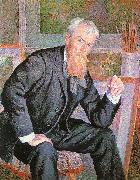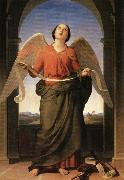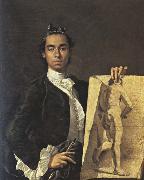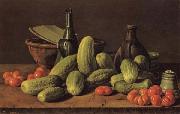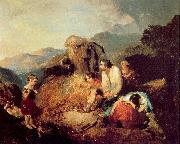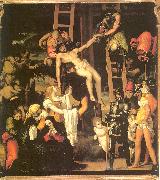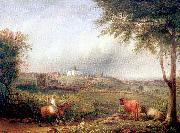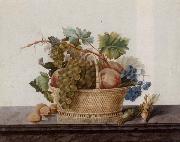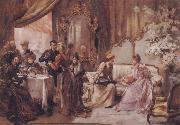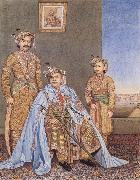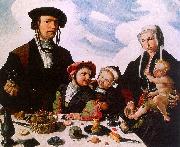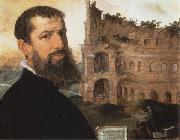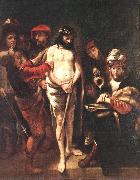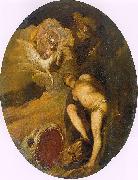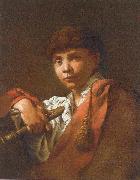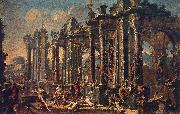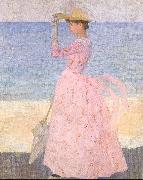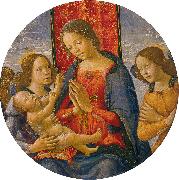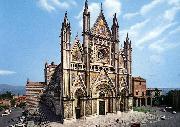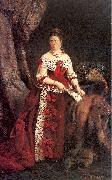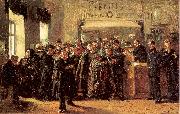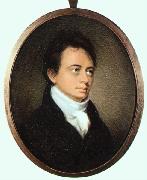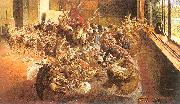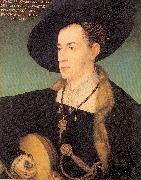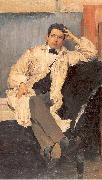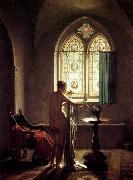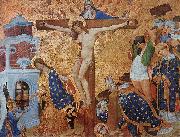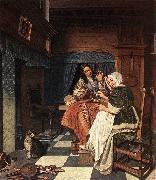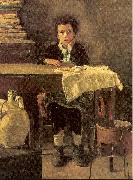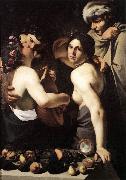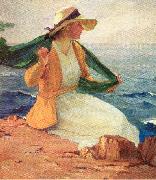|
|
|
|
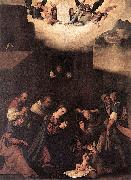 |
Ludovico Mazzolino
|
|
(1480 - c. 1528) - also known as Mazzolini da Ferrara, Lodovico Ferraresa, and Il Ferrarese - was an Italian Renaissance painter active in Ferrara and Bologna.
He was born and died in Ferrara. He appears to have studied under such as Lorenzo Costa, who also trained Dosso Dossi and Cosimo Tura, and came under the influence of Ercole Roberti. In 1521 he married Giovanna, the daughter of Bartolomeo Vacchi, a Venetian painter. Much of his work was commissioned by the duke Ercole I d'Este from Ferrara. Mazzolino was influenced by il Garofalo and Boccaccino. He is known for devotional cabinet pictures, in a style somewhat regressive, or primitive, relative to the modern classicism then emerging. For example, his Massacre canvas has a turbulent and cartoonish crowding.
The exact date, or even year, of his death is not known, but he died during a plague which devastated the area.
|
|
|
|
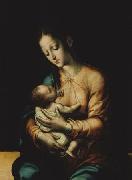 |
Luis de Morales
|
|
(1510 - 9 May 1586) was a Spanish painter born in Badajoz, Extremadura. Known as "El Divino", most of his work was of religious subjects, including many representations of the Madonna and Child and the Passion.
Influenced, especially in his early work, by Raphael Sanzio and the Lombard school of Leonardo, he was called by his contemporaries "The Divine Morales", because of his skill and the shocking realism of his paintings, and because of the spirituality transmitted by all his work.
His work has been divided by critics into two periods, an early stage under the influence of Florentine artists such as Michelangelo and a more intense, more anatomically correct later period similar to German and Flemish renaissance painters
|
|
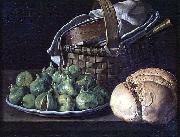 |
Luis Egidio Melendez
|
|
(Naples, 1716-Madrid, 1780) was a Spanish painter. Although he received little acclaim during his lifetime and died in poverty, Melendez is recognized today as the greatest Spanish still-life painter of the 18th century. His mastery of composition and light, and his remarkable ability to convey the volume and texture of individual objects enabled him to transform the most mundane of kitchen fare into powerful images.
Luis Egidio Melendez de Rivera Durazo y Santo Padre was born in Naples in 1716. His father, Francisco Melendez de Rivera Diaz (1682- after 1758), was a miniaturist painter from Oviedo who had moved to Madrid with his older brother, the portrait painter Miguel Jacinto Melendez (1679-1734) in pursuit of artistic instruction. Whereas Miguel remained in Madrid to study and became a painter in the court of Philip V, Francisco left for Italy in 1699 to seek greater artistic exposure. Francisco took a special interest in visiting the Italian academies and settled in Naples where he married Maria Josefa Durazo y Santo Padre Barrille.Luis was a year old when his father, who had been a soldier in a Spanish garrison and lived abroad for almost two decades, returned to Madrid with the family. Luis Egidio, his brother Jose Agusten, and Ana, one of his sisters, began their careers under the tutelage of their father, who was appointed the King's Painter of Miniatures in 1725.After several years, in his words: painting royal portraits in jewels and bracelets to serve as gifts for envoys and ambassadors, he entered the workshop of Louis Michel van Loo (1707-1771), a Frenchman who had been made royal painter of Philip V of Spain. Between 1737 to 1742, Melendez worked as a part of a team of artist dedicated to copying van Loo's prototypes of royal portraits for the domestic and overseas market, but at least he had a foothold in the palace. He had his artistic sights on a distinguished career as a court painter. |
|
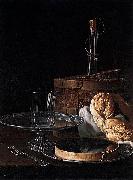 |
Luis Eugenio Melendez
|
|
(Naples, 1716-Madrid, 1780) was a Spanish painter. Although he received little acclaim during his lifetime and died in poverty, Melendez is recognized today as the greatest Spanish still-life painter of the 18th century. His mastery of composition and light, and his remarkable ability to convey the volume and texture of individual objects enabled him to transform the most mundane of kitchen fare into powerful images.
Luis Egidio Melendez de Rivera Durazo y Santo Padre was born in Naples in 1716. His father, Francisco Melendez de Rivera Diaz (1682- after 1758), was a miniaturist painter from Oviedo who had moved to Madrid with his older brother, the portrait painter Miguel Jacinto Melendez (1679-1734) in pursuit of artistic instruction. Whereas Miguel remained in Madrid to study and became a painter in the court of Philip V, Francisco left for Italy in 1699 to seek greater artistic exposure. Francisco took a special interest in visiting the Italian academies and settled in Naples where he married Maria Josefa Durazo y Santo Padre Barrille. Luis was a year old when his father, who had been a soldier in a Spanish garrison and lived abroad for almost two decades, returned to Madrid with the family. Luis Egidio, his brother Jose Agusten, and Ana, one of his sisters, began their careers under the tutelage of their father, who was appointed the King's Painter of Miniatures in 1725. After several years, in his words: painting royal portraits in jewels and bracelets to serve as gifts for envoys and ambassadors, he entered the workshop of Louis Michel van Loo (1707-1771), a Frenchman who had been made royal painter of Philip V of Spain. |
|
|
|
|
|
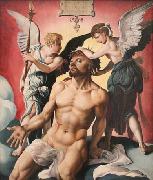 |
Maarten van Heemskerck
|
|
(1498 - 1 October 1574) was a Dutch portrait and religious painter, known for his depictions of the Seven Wonders of the World.
He was born at Heemskerk, North Holland, halfway between Alkmaar and Haarlem.
His father was a small farmer, Jacob Willemsz. van Veen (whose portrait he painted). According to his biography, written by Karel van Mander, he was apprenticed to Cornelis Willemsz in Haarlem. Recalled after a time to the paternal homestead and put to the plough or the milking of cows, young Heemskerk took the first opportunity that offered to run away, and demonstrated his wish to leave home for ever by walking in a single day the 80 km which separate his native hamlet from the town of Delft. There he studied under Jan Lucasz whom he soon deserted for his contemporary Jan van Scorel of Haarlem. Even today, many of Heemskerck's paintings are mistaken for work by van Scorel. He boarded at the home of the wealthy Pieter Jan Foppesz (the van Mander spelling is Pieter Ian Fopsen), curate of the Sint-Bavokerk. He knew him because he owned a lot of land in Heemskerck. This is the same man whom he painted in a now famous family portrait, considered the first of its kind in a long line of Dutch family paintings.
|
|
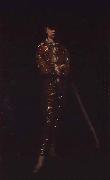 |
Mabel Pryde
|
|
(February 12,1871, Edinburgh - July 1918, England.) was an artist, best known for being the wife of artist William Nicholson and mother of artists Ben Nicholson and Nancy Nicholson and the architect Christopher 'Kit' Nicholson.
Mabel was the daughter of David Pryde, Headmaster of Edinburgh Ladies College 1870-1891, and Barbara Lauder, whose father William was a brother of the famous Scottish artists Robert Scott Lauder and James Eckford Lauder. Mabel had one brother, the artist James Pryde. As children they lived at 10 Fettes Row, a north-facing Edinburgh house.
Pryde trained at the Bushey School of Art under the tutilage of Hubert von Herkomer. Here she met fellow student William Nicholson whom she married in 1893. She introduced Nicholson to her brother James and all three moved to Eight Bells, Denham, Buckinghamshire, where Nicholson and James Pryde would collaborate on the famous series of lithographic posters they disseminated under the pseudonym J. & W. Beggerstaff.
Pryde and Nicholson had four children - Ben (1894-1982); Anthony (1897-1918) who was killed in action during the First World War; Annie Mary "Nancy" (1899-1978), and Christopher "Kit" (1904-1948). In July 1918 Pryde died from influenza in during the 1918 flu pandemic and was survived by her husband.
|
|
|
|
|
|
|
|
|
|
|
|
|
|
|
|
|
|
|
|
|
|
|
|
|
|
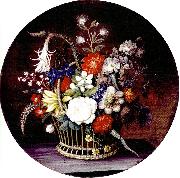 |
magdalene margrethe barens
|
|
Magdalene Margrethe Bärens, född 1737, död 1808, var en dansk konstnär; hon blev den första kvinnliga konstnären i Danmark som valdes in i den danska konstakademin år 1780.
Hon var en av de få kvinnliga konstnärerna kända i Skandinavien före 1800-talet, tillsammans med Ulrika Pasch i Sverige och Helena Arnell i Finland. I Danmark var även Johanne Marie Fosie känd under samma tid. |
|
|
|
|
|
|
|
magritte
|
|
Rene Francois Ghislain Magritte (21 November 1898 -- 15 August 1967) was a Belgian surrealist artist. He became well known for a number of witty and thought-provoking images. His intended goal for his work was to challenge observers' preconditioned perceptions of reality and force viewers to become hypersensitive to their surroundings. |
|
|
|
|
|
|
|
|
|
|
|
|
|
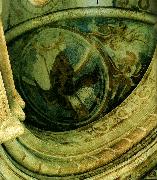 |
majestas domini
|
|
Christ in Majesty, or Christ in Glory, in Latin Majestas Domini, is the Western Christian image of Christ seated on a throne as ruler of the world, always seen frontally in the centre of the composition, and often flanked by other sacred figures, whose membership changes over time and according to the context. The image develops from Early Christian art, which directly borrowed the formulae of depictions of the enthroned Roman Emperor. In the Byzantine world, the image developed slightly differently into the half-length Christ Pantocrator, "Christ, Ruler of All", a usually unaccompanied figure, and the Deesis, where a full-length enthroned Christ is entreated by Mary and St. John the Baptist, and often other figures. In the West, the evolving composition remains very consistent within each period until the Renaissance, and then remains important until the end of the Baroque, in which the image is ordinarily transported to the sky. |
|
|
|
|
|
|
|
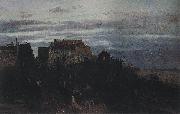 |
Maksymilian Gierymski
|
|
Gierymski (Warsaw 1846 - Reichenhall, Bavaria 1874) was a Polish painter, specializing mainly in watercolours. He was the older brother of painter Aleksander Gierymski.
As a seventeen-years-old boy, he participated in the January Uprising. He was educated at the Warsaw Drawing School initially, but then received a government scholarship in 1867 and went to study at the Academy of Fine Arts in Munich. He became one of the leading painters of the Munich realistic school. Initially best known for this battle paintings, he also created many landscape paintings, especially of southern Poland, which he visited several times.
Successful western Europe completely, he did not gain approval nor popularity in Poland of the 19th century, although he sent paintings to exhibitions in Warsaw regularly from 1968 on. He did however win awards at exhibitions in Munich (1869) and in Berlin (1872).
|
|
|
|
|
|
|
|
|
|
|
|
|
|
|
|
|
|
|
|
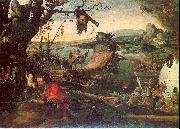 |
Mandyn, Jan
|
|
Dutch Northern Renaissance Painter, ca.1500-1560 |
|
|
|
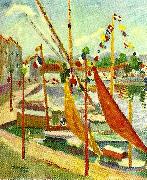 |
manguin
|
|
Henri Charles Manguin (Paris, 23 March 1874 - Saint-Tropez, 25 September 1949) was a French painter, associated with Les Fauves.
Manguin entered the Ecole des Beaux-Arts to study under Gustave Moreau, as did Matisse and Charles Camoin with whom he became close friends. Like them, Manguin made copies of Renaissance art in the Louvre.
Manguin was very much influenced by impressionism, as is seen in his use of bright pastel hues.
He married in 1899 and made numerous portraits of his wife, Jeanne, and their family. In 1902, Manguin had his first exhibition at the Salon des Independants and d'Automne. Many of his paintings were of Mediterranean landscapes; these represented the height of his career as a Fauve artist.
He traveled extensively with Albert Marquet throughout Southern Europe. In 1949, Manguin left Paris to settle in Saint-Tropez, where he died soon after, on September 25, 1949. |
|
|
|
|







